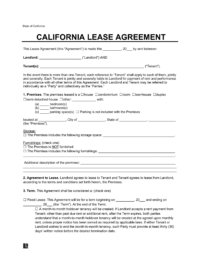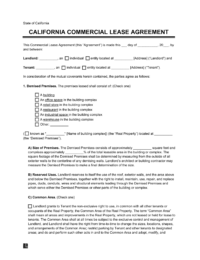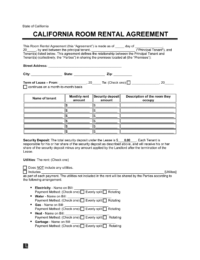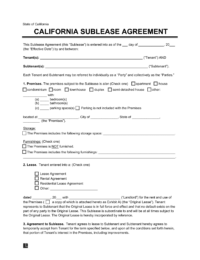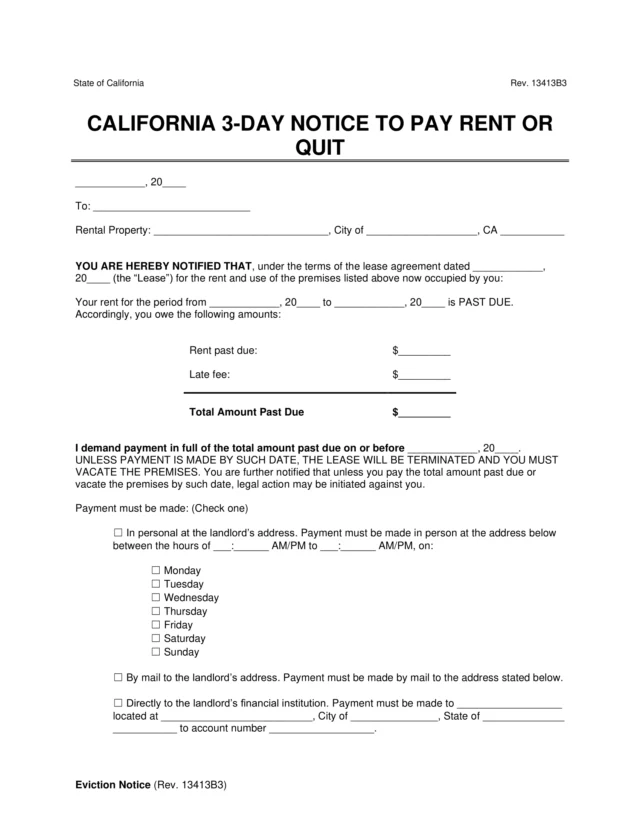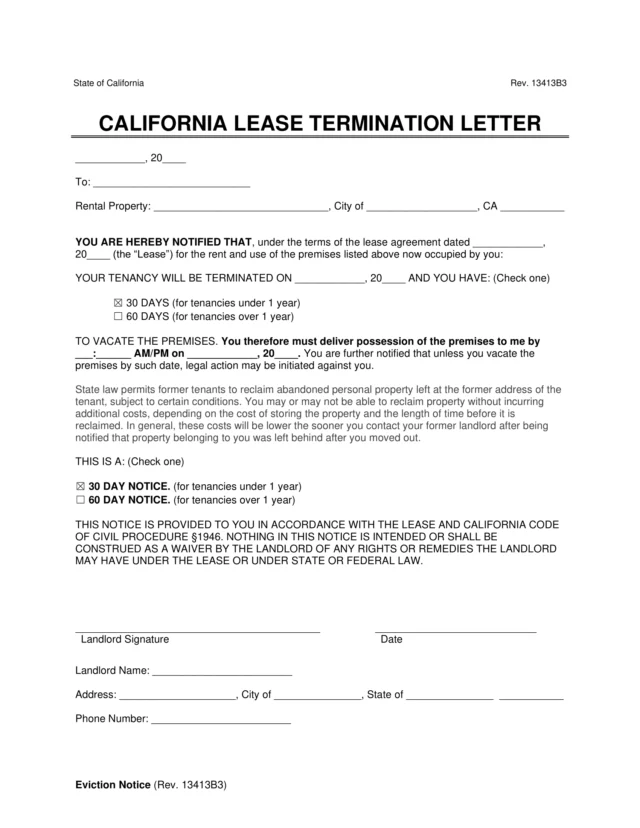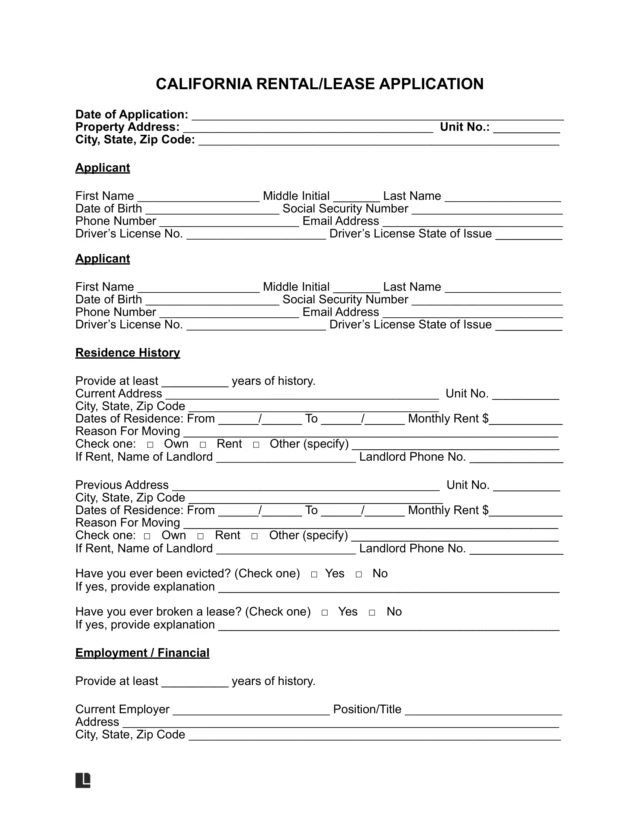What Is a California Lease Agreement?
A California lease agreement outlines key rental terms like rent amount, security deposit, and tenant responsibilities while helping landlords comply with state regulations. It ensures that the tenant has the right to use the property in exchange for rent payments. If the tenant defaults on their duties, the contract protects landlords by giving grounds for eviction.
Overview of Landlord-Tenant Laws in California
A California lease agreement must abide by state laws to be enforceable. Review some of the key regulations below.
| Topic | Rule | Law |
|---|---|---|
| Security deposit maximum | One month's rent (two months' rent in rare cases) | CA Civ Code § 1950.5 |
| Security deposit return | Within 21 days | CA Civ Code § 1950.5 |
| Annual rent increases | Limited to a maximum of 5% plus inflation or 10% of the previous year's lowest rent | CA Civ Code § 1947.12 |
| Deducting rent | Tenants may deduct up to one month's rent for landlord-caused uninhabitable conditions | CA Civ Code § 1942 |
| Price gouging protections | It's illegal to increase rental prices by more than 10% following an emergency declaration | CA Penal Code § 396 |
| Landlord entry | 24 hours' notice (for non-emergency situations) | CA Civ Code § 1954 |
Types of California Lease Agreements
Knowing your lease type can help you document your desired terms accurately. In California, leases of more than one year must be in writing under the Statute of Frauds. However, you should get any lease, no matter its length, in writing for clarity. Review the different types of California leases below to find one that fits your needs.
California Standard Lease Agreement
Legally binds a landlord and tenant to a fixed-term rental arrangement.
California Month-to-Month Rental Agreement
Automatically renews on a monthly basis, allowing either party to terminate with proper notice.
California Commercial Lease Agreement
Enables a business to rent office or retail spaces.
California Room Rental Agreement
Allows a principal tenant to rent an individual room on their leased property to another tenant.
California Sublease Agreement
Allows a tenant to rent all or part of their leased property to another party, while retaining responsibility to the original landlord.
California Rent-to-Own Lease Agreement
Provides tenants an exclusive option to purchase a property at a predetermined price.
City-Specific Lease Considerations in California
Major cities like Los Angeles, San Diego, San Jose, San Francisco, Fresno, Long Beach, and Sacramento have specific local regulations. Review the laws in your area while drafting a California residential lease agreement to ensure full compliance.
California Security Deposit Requirements
California law limits security deposits and outlines how and when tenants must get them back.
A California landlord cannot charge more than one month’s rent as a security deposit in most cases (CA Civ Code § 1950.5). They can charge up to two months’ rent if the following two conditions are met:
- The landlord is a natural person or an LLC in which all members are natural persons.
- The landlord owns no more than two residential rental properties that include no more than four dwelling units.
State law doesn’t require landlords to store the security deposit in a specific bank account. It also doesn’t require the payment of interest on the deposit to the tenant. Local regulations may vary, so review applicable laws to ensure compliance.
Once the tenant moves out, the landlord has 21 days to issue an itemized statement and return any balance (CA Civ Code § 1950.5). Sometimes, the necessary repairs cannot be completed within the 21-day period. In this case, the landlord can provide a good-faith estimate of the charges. Once the repairs are done, the landlord has 14 days to finalize the itemized statement and update the tenant.
California Rent Payment and Late Fee Policies
State law doesn’t require rent to be due on a specific date. Landlords and tenants must refer to the date mentioned in the lease agreement. It’s commonly the first of the month, but the parties can set a different date.
California limits annual rent increases to a maximum of 5% plus inflation or 10% of the previous year’s lowest rent (CA Civ Code § 1947.12). This statewide rent control applies until 2030 but does not supersede existing city ordinances.
Landlords may charge reasonable late fees outlined in the lease. No grace period is required, and landlords can issue a 3-day notice to quit for late rent. Failure to comply may initiate eviction proceedings.
Tenants may deduct up to one month’s rent for landlord-caused uninhabitable conditions (CA Civ Code § 1942). For severe health and safety risks, tenants can withhold rent until repairs are made.
California Price Gouging Protections
California enforces strict price gouging laws to prevent landlords from exploiting emergencies. Under CA Penal Code § 396, it is illegal to increase rental prices by more than 10% following an emergency declaration. Even properties exempt from AB 1482 (California Tenant Protection Act of 2019) may still be subject to price-gouging limitations during an emergency. Here is what to know:
- Rent cap enforcement: Any rent increase exceeding 10% is illegal unless it qualifies for an exception.
- Repair-related increases: If a landlord makes improvements beyond routine maintenance, they may raise rent beyond the cap. However, the cost must be distributed over time.
- Covered rental agreements: Price gouging rules primarily apply to leases of one year or less.
Landlords caught price gouging can face fines up to $10,000, jail time, or both. Protections typically remain in place for 30 days after an emergency declaration. For a list of locations under price gouging protections, visit the California Governor’s Office of Emergency Services.
Landlord Right of Entry in California
A landlord can enter a property without notice in case of an emergency. In most other cases, proper notice must be given to respect tenants’ privacy. To show the property or conduct maintenance/repairs, a landlord must issue 24 hours’ notice (CA Civ Code § 1954).
If the landlord will conduct a move-out inspection, they must give at least 48 hours’ notice (CA Civ Code § 1950.5).
Property Repair and Maintenance Responsibilities in California
California landlords must keep rental units fit for human occupation and repair all subsequent dilapidations (CA Civ Code § 1941). If the landlord fails to make necessary repairs, the tenant can use the “Repair and Deduct Remedy.” This allows them to make the repairs themselves and deduct the costs from their rent (CA Civ Code § 1942). This remedy may only be used twice within a 12-month period.
Tenants have a general responsibility to maintain the rental unit and keep it clean and sanitary (Justia).
Required Lease Disclosures in California
California law requires landlords to provide certain disclosures to tenants to promote transparency and safety. These disclosures help avoid disputes and ensure compliance with state rental laws. The state’s Civil Code outlines the following disclosures for a California residential lease agreement:
Health and Safety Disclosures
These disclosures help ensure tenants live in safe and hazard-free conditions:
- Disclosure of Lead-Based Hazards: Required for properties built before 1978 (Title 42 US Code § 4852(d)).
- Carbon Monoxide Detector Notice: Landlords must inform tenants of their detector maintenance duties (CA Health and Safety Code § 17926.1).
- Mold Disclosure: If the landlord is aware of mold, they must notify tenants (CA Health & Safety Code § 26147).
- Asbestos Disclosure: This applies to buildings built before 1979 (CA Health & Safety Code § 25915).
Property Condition and Environmental Risks
These disclosures inform tenants of potential risks associated with the property or location:
- Flood Hazard Disclosure: Needed if the property is in a flood zone (CA Govt Code § 8589.45).
- Notice of Illegal Substance Contamination: If the rental was used for methamphetamine production, tenants must be informed (CA Health and Safety Code § 25400.45).
- Notice of Death in Rental Unit: Tenants must be notified of any unnatural death in a unit within the last three years (CA Civ Code § 1710.2).
- Disclosure of Ordnance Location: If the property is near a former military training facility, tenants must be warned about possible unexploded munitions (CA Civ Code § 1940.7).
- Notice of Intent to Demolish: A landlord must notify tenants of the earliest possible demolition date (CA Civ Code § 1940.6).
Rental Terms and Tenant Rights
These disclosures clarify financial and legal responsibilities for tenants and landlords:
- Disclosure of Shared Utilities: Landlords must explain cost allocation if units share electricity or gas.
- Notice of Foreclosure: A landlord must disclose whenever their property has entered foreclosure (CA Civ Code § 2924.8).
- Rent Control & Just Cause Addendum (AB 1482). It limits rent increases and requires a valid reason to end a lease.
- Megan’s Law Notice: This notice informs tenants about their right to access California’s sex offender registry. Landlords must include a lease provision directing the tenant to the Department of Justice website.
Additional Lease-Specific Notices
These disclosures apply to specific rental situations:
- Bed Bug Addendum: Landlords must provide information about bed bugs (CA Civ Code § 1954.603).
- Notice of Pest Control/Pest Control Service: Landlords must offer certain pest control information (CA Civ Code § 1954.603).
- Smoking Policy Disclosure: Landlords must describe prohibited smoking areas (CA Civ Code § 1947.5).
Terminating a Lease in California
Landlords can terminate the lease with a 30-day notice if the tenancy is less than a year old. They must use a 60-day notice if it has lasted a year or more.
Landlords must notify tenants to collect their belongings within 15 days if hand-delivered, or 18 days if sent by mail (California Courts). Unclaimed property will be sold at a public auction unless its total value is under $700, in which case the landlord can dispose of it.
Sample Lease Agreement for California
View our free sample lease agreement for California to learn its structure. Then, create your own using our guided questionnaire and download a copy in PDF or Word format.



